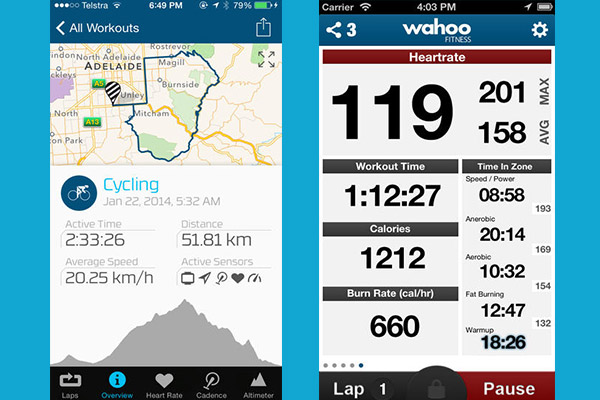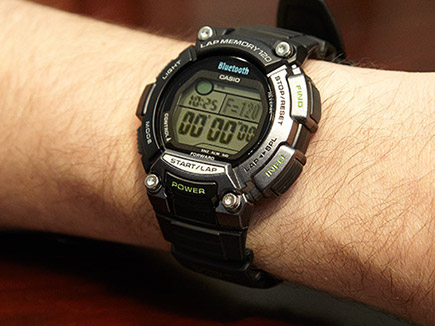Tom's Guide Verdict
The Casio STB-1000 watch pairs with your iPhone to deliver workout info and notifications, but a small display and limited app support make it an also-ran.
Pros
- +
Inexpensive
- +
Long battery life
- +
Durable and water resistant
Cons
- -
Tiny notifications window
- -
Only works with iOS
- -
Limited app support
- -
Unintuitive interface
Why you can trust Tom's Guide
Unlike many fitness bands, which gather information on their own and relay it to your phone, the Casio STB-1000 watch takes data from a fitness app on your phone and displays it on your wrist. This $99 timepiece-first device also lets you control your music and view notifications from apps such as email, Facebook and Twitter. Is this the watch to take on your next run?
Design

The Casio STB-1000 looks like, well, a Casio. Largely black with gray and green accents, the STB-1000 has a rugged, industrial look. While it's not ugly, this watch would look more out of place in a more formal setting than would the Cookoo or the Martian Notifier, or even the Magellan Echo. Unlike the Cookoo and Martian, the Casio has an all-digital face that doesn't look much different from something you could purchase 20 years ago.
On the right side are buttons for Light and Mode; on the left are two other buttons to start and stop the stopwatch, and to control other functions, such as music. Below the display is a fifth button to pair and unpair the watch from your phone. This button also controls other features depending on the context.
MORE: Best Smartwatches
At 1.9 ounces, the Casio STB-1000 is heavier than the 1.55-ounce Magellan Echo and 1.8-ounce Martian Notifier, but much lighter than the 2.7-ounce Cookoo. The Casio measures 2.06 x 1.85 x 0.61 inches, making it chunkier than the Echo (1.9 x 1.8 x 0.5 inches), Martian (1.7 x 1.7 x 0.5 inches) and Cookoo (1.75 x 1.75 x 0.6 inches). However, the Casio is water resistant to 100 meters.
Setup
In order for the Casio STB-1000 to interact with your iPhone — sorry, no Android support yet — you must first install the Casio Watch+ app on your iPhone. After that, press and hold the Power button on the watch for two seconds to pair it with your phone. A small Bluetooth icon will appear in a green circle on the watch.
App

The Casio Watch+ app lets you adjust the kind and form of notifications that will arrive on the watch. For instance, when you get a call, you can have the watch buzz and/or play a tone, as well as show the name or number of the caller. The same goes for text messages, voicemail, calendar alerts and email from the iPhone's native apps. You can also receive alerts from third-party apps such as Facebook and Twitter.
While you can change the Casio's vibration from one to three buzzes, you can't set custom vibrations for specific alerts, as you can with the Martian Notifier.
Display

The circular face of the STB-1000's display is cropped at the top and bottom, and is divided into three sections. In normal watch mode, the lower half shows the current time, while the upper half, which is bisected vertically, shows the date on the left and the day of the week on the right.
In this mode, if you receive a notification, the upper right window will change to display the message. It's a painfully small window, though. The watch caps any message to a few characters, but it still takes a while to read. For example, when we received a text message reading, "The quick brown fox jumped over the lazy dogs," it was abridged to "The quick brown fo," but still took 12 seconds to scroll.
When the Casio receives an alert, you can tap the display twice to dismiss that notification. This was more useful for alarms, as most message alerts only lasted a few seconds.
Music Control
Pressing and holding the Mode button (the lower left) activates the Music mode on the Casio STB-1000; the window in the upper right says "Music."
From there, press the Power button to start playing music (press it again to pause). The name of the track appears in the upper right window, slowly scrolling across. To advance to the next track or go back a song, simply double-press one of the buttons on the right. It was equally easy to change the volume using the left buttons.
Being able to control our iPhone's music from the Casio was probably the most useful smartwatch feature the device offered. Not only did this feature work well, but because song titles are often short, we didn't lose patience waiting for them to scroll. However, you can only control music stored on your iPhone, and not from streaming music services.
MORE: Smartwatch Buying Guide: 8 Things You Need to Know
Exercise

Fitness enthusiasts can pair the Casio with one of four apps: three from Abvio (Runmeter, Walkmeter and Cyclemeter), as well as Wahoo Fitness. The Magellan Echo has an equally anemic selection of apps from which you can choose (Wahoo Fitness, Strava, MapMyRun and iSmoothRun). However, MapMyRun is in the top five most popular apps for the Health & Fitness category on the iPhone, whereas Walkmeter is the 42nd most popular. What's worse, you can't pair the Casio with any of Abvio's apps unless you pay for the premium versions, which cost $4.99 each.
When we used the free Wahoo Fitness app, it showed our distance in the upper right, the elapsed time in the upper left and pace in the main screen. If you have a heart monitor paired to the watch, the screen will cycle between the first view and a second view that shows your beats per minute.
When in this mode, pressing the button on the upper right of the Casio let us pause and unpause our workout (you have to use the Start and Stop buttons in the app to initiate or end a workout). Pressing the button on the lower right let us start a new lap. Pressing the button on the lower left started playing music and let us advance tracks, but wouldn't let us pause music or change the volume.
Other Features

The Casio itself (without an iPhone) also offers a wide range of other sports watch functions, including a function to record up to 120 lap times, a stopwatch, countdown timer, up to five daily alarms and world time. However, figuring out the correct sequence of buttons to push for a given operation is like executing a "Contra" cheat code. The printed instructions that come with the phone aren't that helpful, either. If you pick up the STB-1000, we suggest studying the online manual (http://support.casio.com/global/en/wat/ble/stb1000/).
Misplace your phone? Provided the Casio and your iPhone are linked via Bluetooth (and in range), you can press a button on the watch, and a tone will start playing on your phone. This feature worked well, and we were able to get about 72 feet away from our phone before the Bluetooth connection failed.
Battery Life
Powered by a standard CR2032 3-volt battery, the STB1000 should last up to two years on a charge, Casio says. By comparison, the Martian Notifier should last about the same amount of time, and the Echo should last up to six months with heavy use and 11 months with light use.
MORE: 15 Best Fitness Apps
Verdict
The Casio STB1000 falls into a nebulous region between fitness bands and full-fledged smartwatches. At $99, it's about the same price as mid-range fitness gadgets, but when paired with your iPhone, it can deliver workout stats to your wrist. While this may be useful to those who want to carry two devices while running, Casio's execution falls flat.
Although it costs $50 more, the Magellan Echo provides much of the same functionality, but works with more popular fitness apps. Moreover, its screen was easier to view while we were running, and its interface was more intuitive. With the STB1000, Casio tried to combine this year's technology with a watch from the 1990s, and the result feels dated.
Follow Michael A. Prospero @mikeprospero and on Google+. Follow us @TomsGuide, on Facebook and on Google+.

Michael A. Prospero is the U.S. Editor-in-Chief for Tom’s Guide. He oversees all evergreen content and oversees the Homes, Smart Home, and Fitness/Wearables categories for the site. In his spare time, he also tests out the latest drones, electric scooters, and smart home gadgets, such as video doorbells. Before his tenure at Tom's Guide, he was the Reviews Editor for Laptop Magazine, a reporter at Fast Company, the Times of Trenton, and, many eons back, an intern at George magazine. He received his undergraduate degree from Boston College, where he worked on the campus newspaper The Heights, and then attended the Columbia University school of Journalism. When he’s not testing out the latest running watch, electric scooter, or skiing or training for a marathon, he’s probably using the latest sous vide machine, smoker, or pizza oven, to the delight — or chagrin — of his family.

